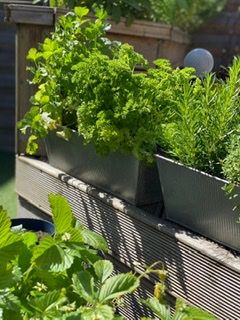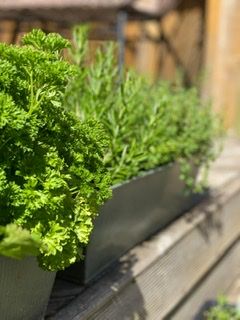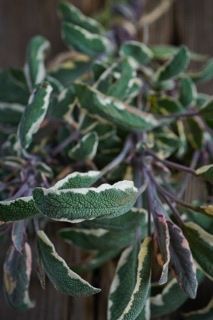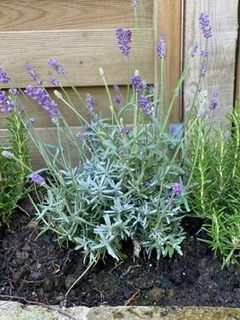Our resident Chef Tim Bilton writes about the importance of herbs in any kitchen.

Herbs are absolutely vital in my kitchen as they make your food come alive.
Without herbs in any kitchen, food would be pretty boring.
Using even just one fresh herb in your cooking will add layers of deep flavour to even the simplest of dishes.
It’s really easy to keep your own fresh herbs too, they tend to have more flavour and end up being a whole lot cheaper in the long run.
Even the smallest of gardens will benefit your cooking with a few "go to" essential herbs.
Growing fresh herbs can be very productive, even in little pots or window boxes. Giving a steady supply of leaves and stems that will add maximum flavour to your cooking at home. Grow as wide a selection as you have room for, whether it’s in beds, baskets, containers, and windowsills or on the patio.

A selection of different herbs is an important component of any budding kitchen cook; herbs are an essential part of cooking.
Try and experiment with different flavour combinations. Mint is a classic partner for new season potatoes and peas, but try them with broad beans or fresh strawberries. French tarragon in homemade custard poured over warm apple pie delicious, you will never look back.
Annual and perennial herbs are brilliant for their abundant summer leaves but also grow evergreen varieties such as rosemary, sage, thyme and bay, grow plenty and this will give you a supply during winter.

Getting started!
Annual herbs generally prefer rich, well drain soil; potting compost is also very good.
Growing annual herbs from seed is easy and very rewarding. You can obtain a good crop from even a tiny space as they don’t require a dedicated bed and can be planted alongside your other plants, or mixed in with boarders and containers.
Herbs such as parsley, dill, basil and coriander, which are grown as an annual, are ideal for pots where the free draining environment suits them perfectly.
Sowing under cover:- fill your pots or trays with compost, water well and allow them to drain.
Sow your seeds thinly on top and then cover with another layer of compost and water lightly.
Once the seedlings are large enough thin them out by easing the compost out and gently splitting into clumps.
Re-pot into larger containers.
Keep the herbs well watered and pay particular attention to those in pots, as they will dry out more quickly. Annual herbs generally don’t need any extra feeding but if the leaves start to go yellow add a little dose of liquid fertilizer.
Perennial herbs range from low creeping plants to large shrubs and can be planted around the garden or left in large pots.
Must Grow Essential Herbs
Parsley
Flat leaf parsley or Italian leaf parsley is the more flavoursome of the varieties. Curly parsley has a milder flavour. Parsley is a biennial herb that will flower and go to seed after two years so keep reseeding to keep germinating year after year.
Rosemary
An aromatic, evergreen shrub both ornamental and versatile, this is a must have herb for your garden or patio. The aromatic leaves are excellent in stews, lamb and roast potatoes. I love the little purple flowers that appear in late summer.
Thyme
There are many varieties of thyme from wild or creeping thyme, silver or lemon thyme to name but three. Should be cut as an when you require them. Brilliant for pots.
This woody aromatic herb grows wild in most warm climates. It has a heady aroma and a sweet, pungent flavour.
Use in a selection of savoury dishes, especially tomato, chicken and game recipes. Thyme also adds a distinctive flavour to soups, vegetarian casseroles and stuffing’s add to carrots when cooking.
Lemon thyme is a brilliant way to lift a roast fish or chicken.
Coriander
Every part of coriander, not just the leaves and seeds, is edible. The stems are where most of the flavour lies, and the roots are crushed and used in Thai curry pastes.
Even the small, lacy pinkish-white flowers add elegance to summer salads. The seeds are used whole or ground, and are often lightly toasted in a dry frying pan first to enhance their flavour.
Coriander seeds after the coriander plant flowers, seed heads form - the seeds are tiny creamy brown-coloured balls. They have a mild, sweet taste. The seeds are either used whole or ground.
The seeds are used extensively in Indian cookery, often dry-fried with cumin seeds and then ground. Whole seeds are used in pork and chicken casseroles and in pickles and chutneys. To gain the maximum flavour from coriander seeds it is best to dry-fry them. Heat a heavy-based frying pan (without any oil), add the seeds and fry them over a medium heat, stirring frequently. When a rich aroma is released, remove from the heat and cool. Use whole or crushed.
Pots of coriander don't remain fresh for long, but you can use all the leaves by freezing them. As soon as the plant shows any signs of wilting, pick all the leaves and stalks, chop them up and use to half fill sections of an ice cube tray. Top the tray up with water and freeze. When you need to add fresh coriander to a recipe, simply place the required number of cubes in a small sieve and as the cubes thaw, the water will drain away leaving you with chopped coriander.
Dried coriander should be stored in an airtight jar in a cool, dry place, away from direct sunlight.
Mint
Mint has scores of different flavoured varieties from spearmint the most common, pineapple, apple and chocolate to ginger. It is almost impossible to fail with it, and is so notoriously invasive that it comes close to being considered a weed. If planting into your herb beds, plant in a bottomless pot in the ground this will help prevent the mint shoots invading other parts of your herb bed.
This popular herb has a distinctive menthol flavour, a strong sweet aroma and a cool aftertaste. It has medium-sized round or pointed leaves.
Other popular varieties include apple mint, which has a sweet and mellow flavour, and peppermint, which has a subtle flavour and is popular in sweets and confectionary.
Common mint is popular in a variety of sweet and savoury dishes. Mint sauce or mint jelly are traditionally served with lamb. New potatoes or peas with butter and sprigs of fresh mint. Mint leaves are a good addition to long, cool summer drinks - as a garnish and to add a subtle, refreshing flavour. Mint is also used as a flavouring in desserts such as ice creams, often combined with chocolate.
Remove leaves from the stem and rinse thoroughly in cold running water. Choose smaller leaves which are found at the top of the plant for garnishing - they are sweeter and will have a better flavour.
Tarragon
This popular and versatile herb has long, narrow soft green leaves. They have a sweet peppery flavour and subtle hints of vanilla and aniseed. Tarragon has an intense flavour and should be used quite sparingly.
Tarragon has anaesthetic quality’s so if over used can numb your tongue and taste buds if over used. But great if you have tooth ache just sit a couple of tarragon leaves next to your gum and it will numb the pain.
Chives
A grass like perennial that is a member of the onion family. If you don’t have a lot of space this attractive herb makes an excellent container plant. Both the leaves and flowers can be eaten.
Chives have a delicate onion flavour and are one of the most well known culinary herbs. Cooking tends to change the flavour, so add just before serving in sauces, soups and stews.
Best used fresh, they can be chopped into sandwiches, salads or used as a garnish. Chives go especially well with cheese, fish and egg dishes.
Sage
This popular herb has greeny grey slightly furry leaves, about 5cm long. They have a strong, aromatic flavour and a slightly bitter flavour.
Sage is often served with pork, liver or goose.
Sage is particularly popular in Italian cookery where it is used in stuffings, and also served with veal and calf's liver. The whole leaves can be deep-fried as a garnish for meat dishes.
Cut this herb back established plants in early spring and pinch out growing shoots in summer to keep bushes compact.
Drying Herbs
Perennial herbs are ideal for drying to use throughout the winter. In summer cut and bunch the stems, and hang them up somewhere warm, dry and well ventilated.
Shorter herbs like thyme, can be laid out on a cooling rack and dried and stored in sealed jars.
Herb Salt
20g Fresh Thyme
20g Fresh Rosemary
1 Lemon zest
10g Fresh Parsley
½ tsp Ground Cumin
50g Sea salt (Maldon)
Place the rosemary and thyme on a clean dry tray and bake at 220c for about 8 minutes or until the herbs are completely dry.
Allow to cool.
Dry the lemon zest in the oven for 2 minutes, remove and allow to cool.
Place the fresh parsley in a food processor or nutribullet and blitz the salt will turn green.
Finally mix the baked rosemary, thyme, zest and cumin into the parsley salt.
Store in airtight container.
This is a great seasoning.






